Cusco and Machu Pichu
The mountains nestle Cusco in their palm.
The arms of three great Andean cordilleras — Vilcabamba, Urubamba and Vilcanola — come together and where they meet, there is something of a natural bowl in the landscape. That’s where Cusco is, at 3,416 meters above sea level, high but not that high considering, and that’s where the Incas long ago decided to build their most important city. It was their “capital” until the Spanish came along and made it their city, the capital for a time of what is now Peru (Lima came a long time after. . .). It’s no surprise to know that Cusco’s pink stone cathedral basilica that dominates the old town, overlooking the beautiful Plaza des Armas, was built between 1560 to 1668 on the very spot where the Incas had their most important temple. That’s what the Christians did: everywhere they sought to establish themselves, they simply grafted their faith onto that was already there, either suffocating the old faith or tweaking and rebranding it as their own. A remarkably successful strategy it has been too.
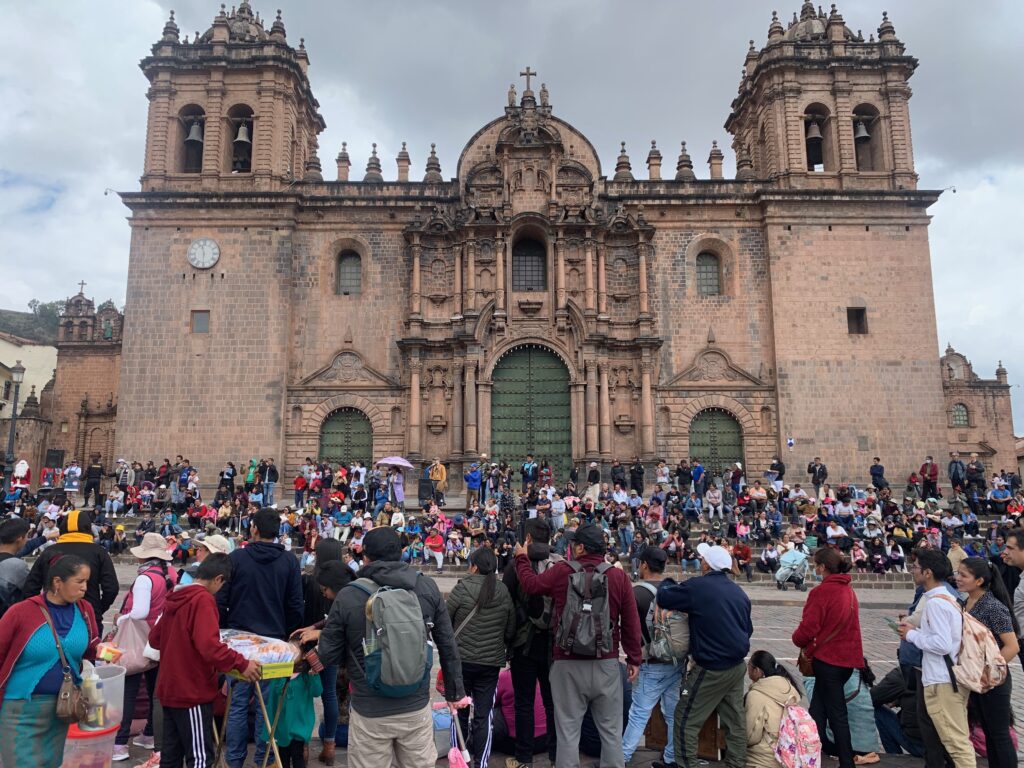
bb
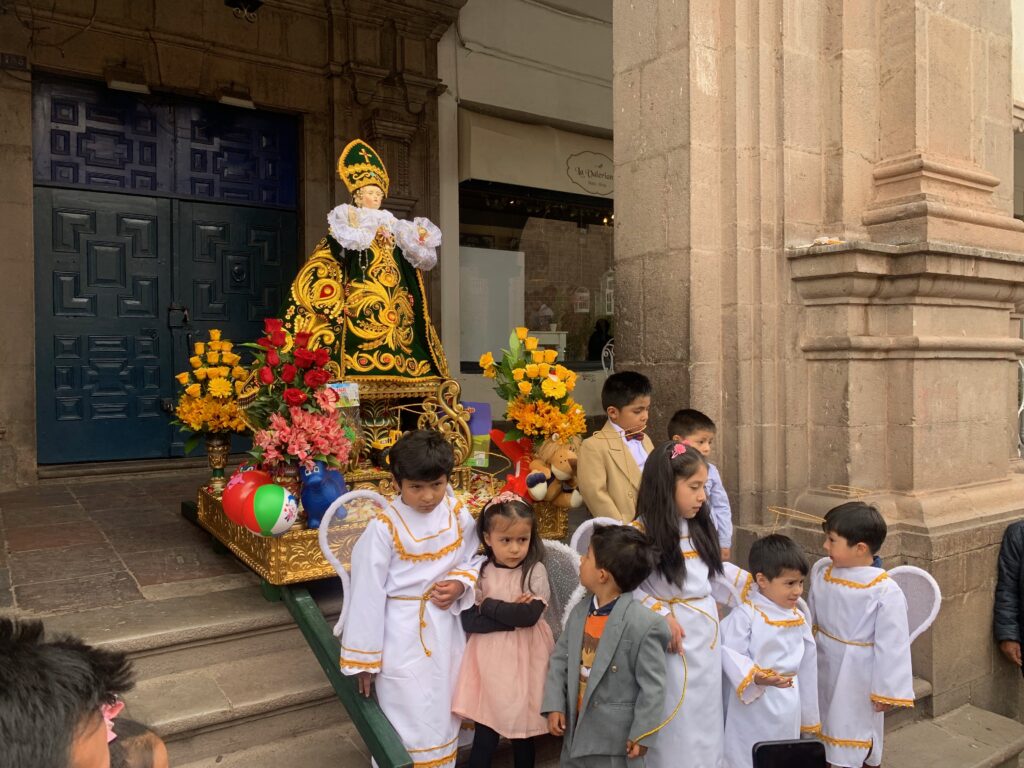
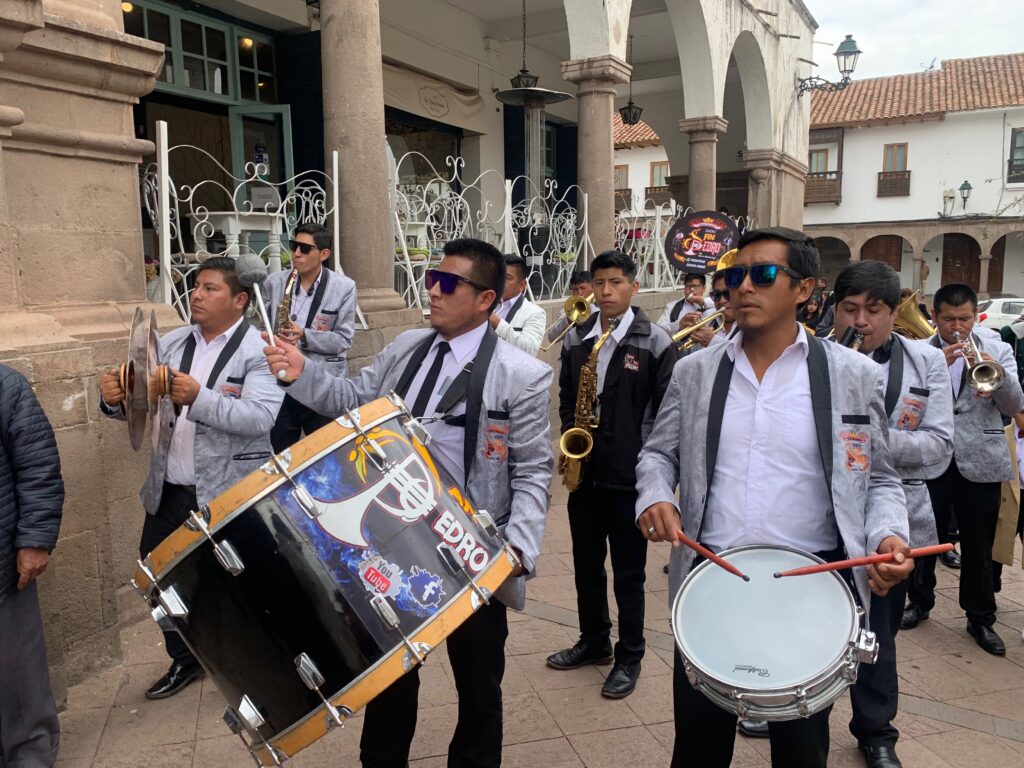
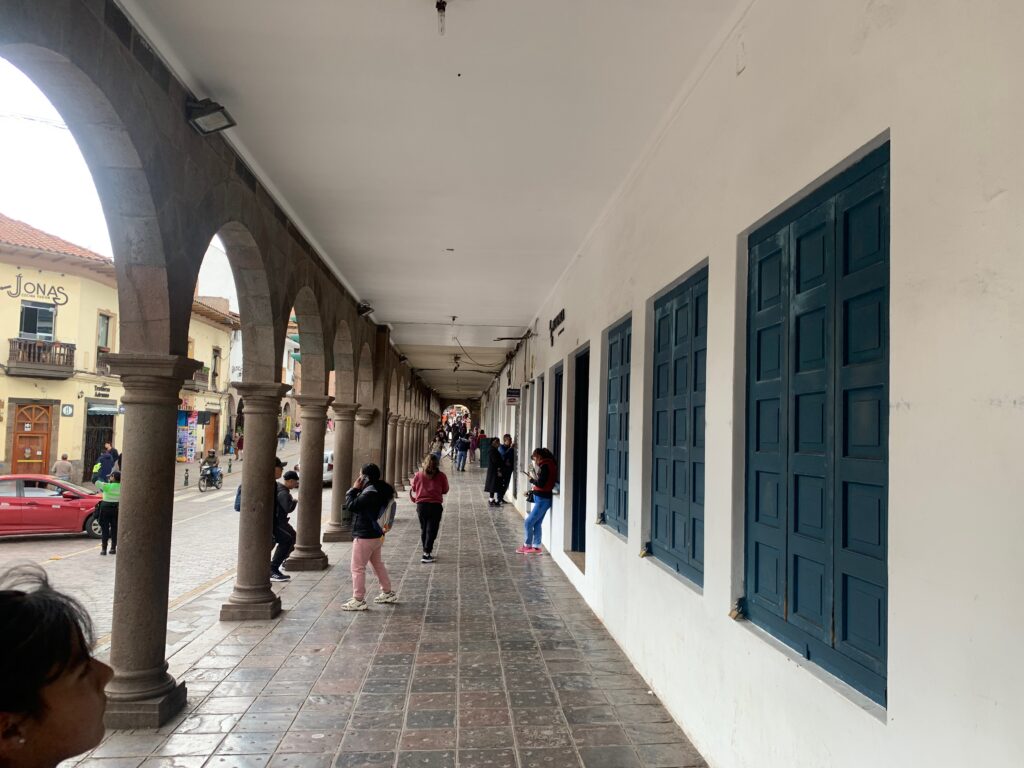
Cusco’s cathedral, Spanish colonial-style colonnade and religious enthusiasm on display.
All the churches of Cusco were doing flying business on my second day in the city. I got there very late on January 4th after a really tough but interesting day negotiating with protesters blocking the roads of south-eastern Peru, in particular the main road from Puno to Cusco itself. The following day was spent resting and indulging in food and drink. January 6th was, of course, Little Christmas, or Nollaig na mBan as it is increasingly known in Ireland. Well, something similar applies in Peru: On January 6th, the Christmas season officially came to an end . . . and Cusco went bananas! The whole Historical Centre of the city was thronged with families out enjoying themselves. A lot of women carried small baskets containing crib-like assortments of extravagantly dressed dolls. At Masses, they brought the baskets forward for blessing by the priest. In one church, the Iglesia de la Compania de Jesus, which was opposite the cathedral basilica (which is a complex of three separate churches), I attended a packed Mass at about noon. There was just one priest and, when I put my head around the door again early in the evening, he was still there saying Mass, one Mass after the other with no breaks in between, as far as I could tell.
Over at the cathedral, in front of the building some sort of ceremony was taking place involving a small version of one of those religious statues that, in Spanish towns and villages, are placed on platforms and carried around the streets on the shoulders of men on the particular saint’s day. In this case, there was a small band whose members, and some of the men involved with the statue, had that slightly creepy look adopted by Spanish lay Catholic activists — all slick back Brylcreem hair, dark suits, shades and expressionless faces.
Inside, the cathedral was typical of its type — over-the-top side chapels dripping in silver and gold; 64 carved wooden choir stalls dating from 1636 and the almost inevitable statue of Santiago Metamoros, St James The Moor Slayer. There was a crib with gaudy flashing lights and, by far the most noteworthy item, an arch of flags over the whole crib, the top one being the LGBT rainbow flag.
As the morning wore on, the police took centre stage in the Plaza, with the canine patrol putting on a display that delighted children and parents alike as the dogs leapt through hoops or danced on their hind legs for their uniformed handlers. A particular favourite was Tiana, a black lab wearing an Inca-style colourful skirt. When the dogs were finished, Santa arrived, accompanied by three young ladies in short skirts and Where’s Wally? style striped leggings. They danced about in front of the cathedral, an overweight police officer with a mic encouraging mums and dads and children to join in, which many did, and then, suddenly, Santa and the dancing wallies were gone. . . disappeared into the crowd, as far as I could tell. There were lots of police around — uniform police mingling with the crowds, riot police with helmets and shields lined up at strategic locations, especially anywhere to do with the administration of justice, and soldiers too.
In terms of tourism, Cusco lives off its Inca heritage far more than its Spanish colonial one, even though that it physically far more obvious — at least in the city. To see the other, you have to travel to Machu Picchu, about five hours away by road. Fleets of mini busses, each carrying 18 people, set off from Cusco close to midnight to reach a hydroelectric station near the foot of Machu Picchu by dawn. I was by far the oldest in our minibus; the average age was probably 35. We were disgorged in the half-light in front of a shabby food and soft drink outlet and directed to start walking. Soon, we were on a railway track that appeared to be linked to the hydroelectric operation but which also, it transpired, was the main access to a small town at the foot of Machu Picchu called, perhaps inevitably, Inca City. It’s also known as Aguas Calientes, hot springs in English, because it has them.
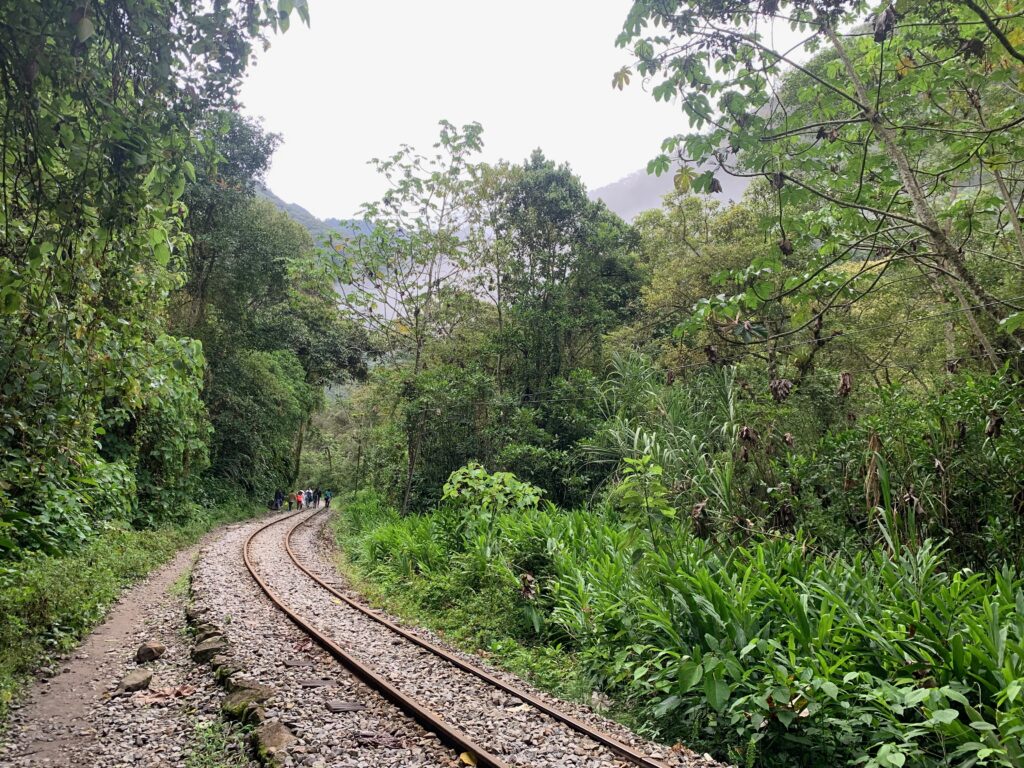
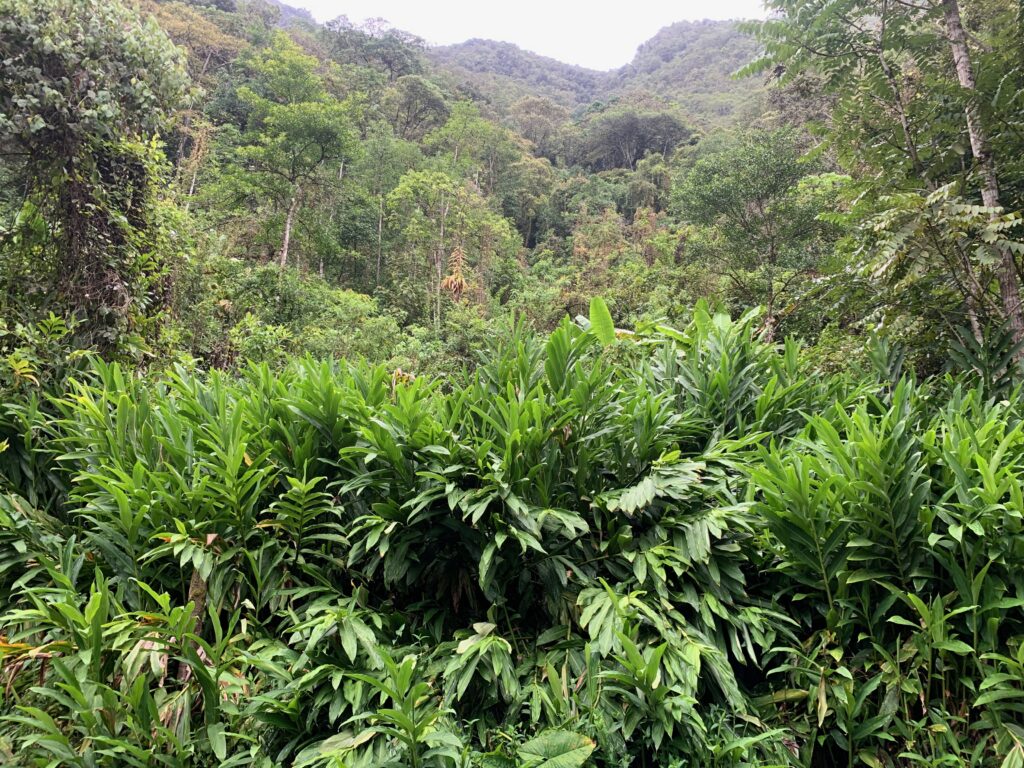
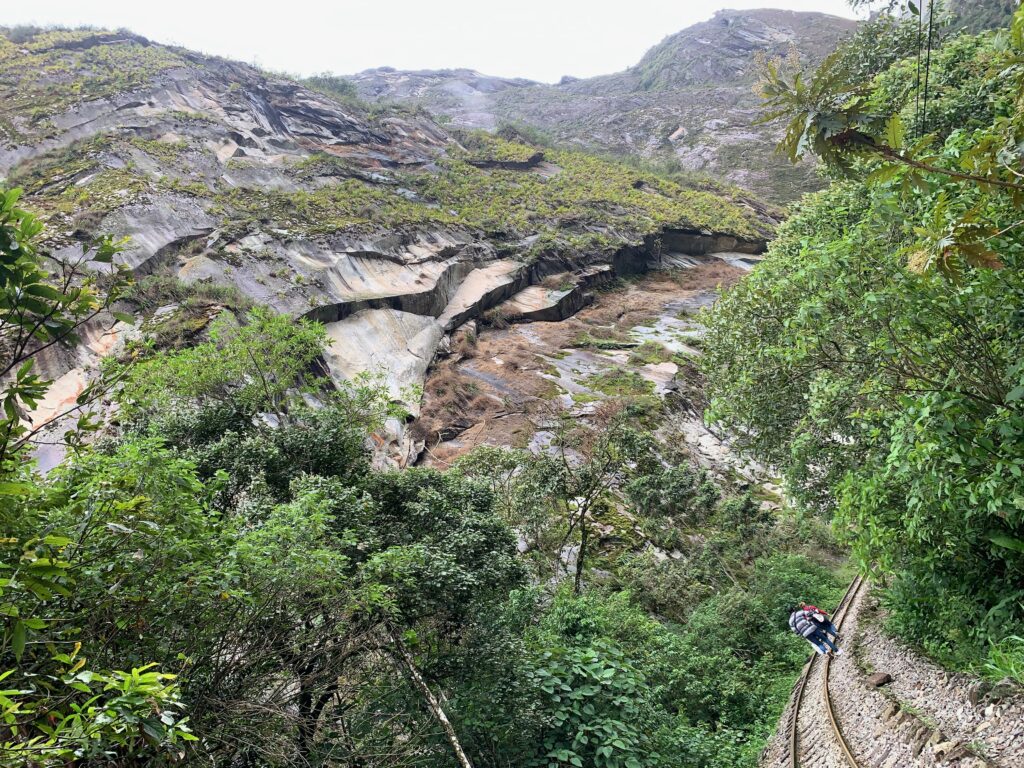
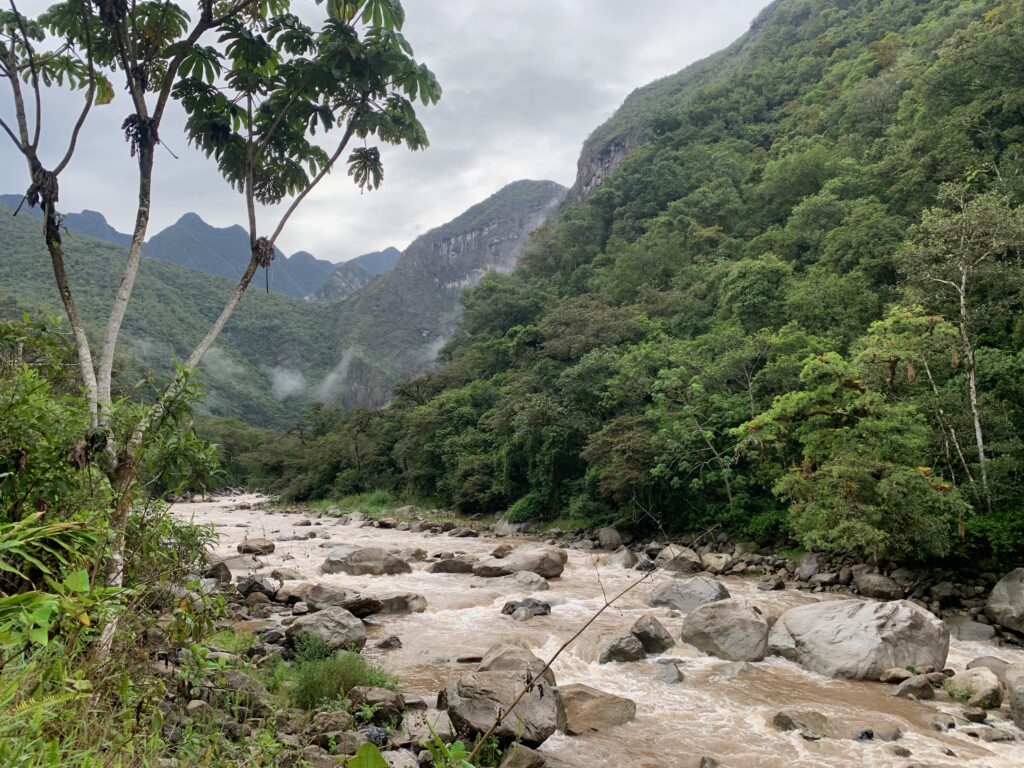
The walk along the railway track through the jungle gorge to the foot of Machu Picchu.
The walk along the railway track was really pleasant, as it turned out. No train was running, for reasons never entirely clear but which seemed to be linked to the anti-government protests. But the scenery was magnificent. We were passing through what was essentially a narrow gorge, whose sheer cliff-face sides were enormously high. In places, I would estimate the rock face to have been a vertical 500 meters top to bottom. The vegetation was sub-tropical. We were, in reality, walking along a train track through jungle (think Bridge on the River Kwai) with all the sights and sounds you’d expect. The river flowing down the gorge was muddy brown, and flowing in places with a sort of wild rage, bashing off granite boulders the size of houses. Every now and then, we’d would pass a homestead — somewhere to sleep and not much else, it seemed. Living was largely in the open, especially the cooking and eating elements of daily life. Chickens scurried through vegetable patches, pecking here and there in the way they do. Some of the homesteads were also hostels; others, especially the one of two on the far side of the river which could be reached only by precarious-looking basket chairs slung beneath cables above the torrent, appeared to be efforts to escape conventional life.
At the foot of Machu Picchu, there was no transport. The fleet of busses that normally ferry tourists up the mountain were all parked in a line and going nowhere, their immobility linked absolutely to the anti-government protests. We would have to climb the stairs up the mountainside — 450 meters and not a gentle gradient either; quite the opposite. By chance when trying to find out what was happening, I came upon the English-speaking guide assigned to our group — which in reality appeared to mean me, as everyone else was Spanish-speaking and happy to do their own thing, and a young Swiss woman named Nicole.
The guide, Ruth Maribiel, lived in Inca City and was married to Robert, who was also a guide, and was mother to three children. The first, most startling, thing she told me was that pre-Covid, in the high season, Machu Picchu was visited by between 6,000 and 8,000 people every day. Once you see the place, the size of it and the narrow walkways, and imagine the noise and clamour of such a huge number of tourists, visiting in such conditions sounds like hell on earth. Luckily for me, there cannot have been more than a few hundred on this day.
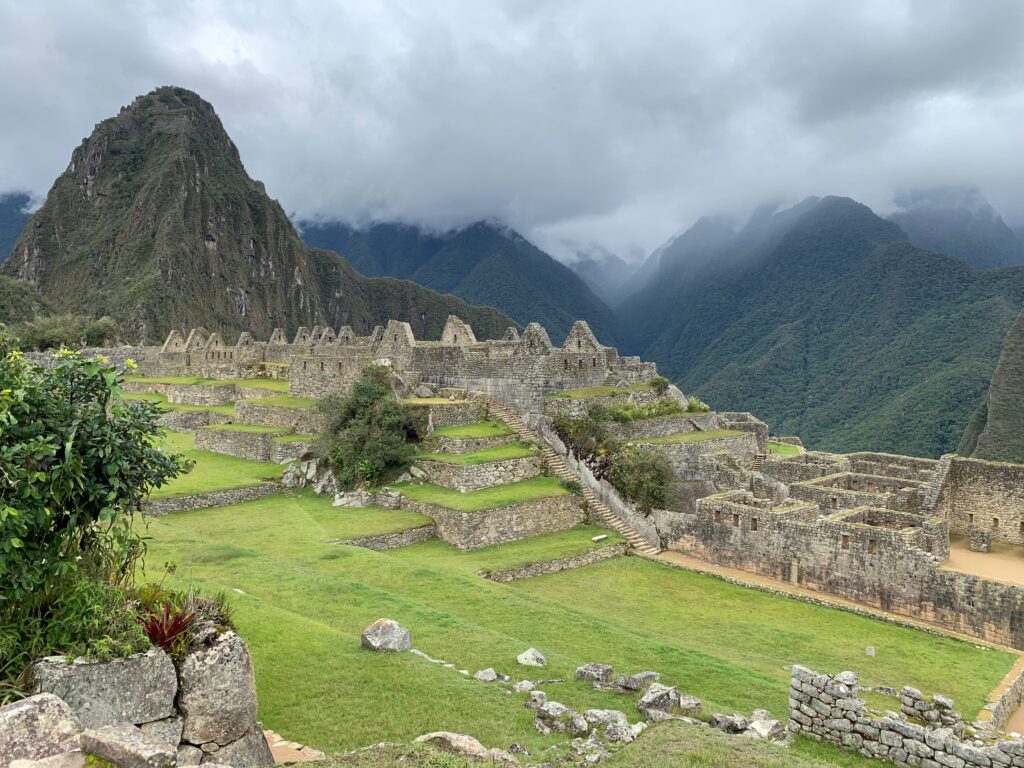
Machu Picchu.
Reaching the top of the top of the stairs one passes through the ticket inspection styles to emerge slightly above Machu Picchu itself. You know that moment when, climbing a mountain, you reach the final ridge and, surmounting it, realise you are at the top — there is nothing above you now. It’s a great elation. Well, that moment on Machu Picchu comes as you round a bend behind the ticketing and cafe complex . . . and realise you are actually a little above the Inca city. There it is below you, spread out across the top of the mountain and, beyond it, the other mountains encircle it, each topped by whisps of candyfloss cloud. There is something ethereal, something other-worldly about the place.
“They came here because they studied astronomy, and [because] the light was clear here, and because of the magnetic concentration in the valleys from the rotation of the earth,” said Ruth.
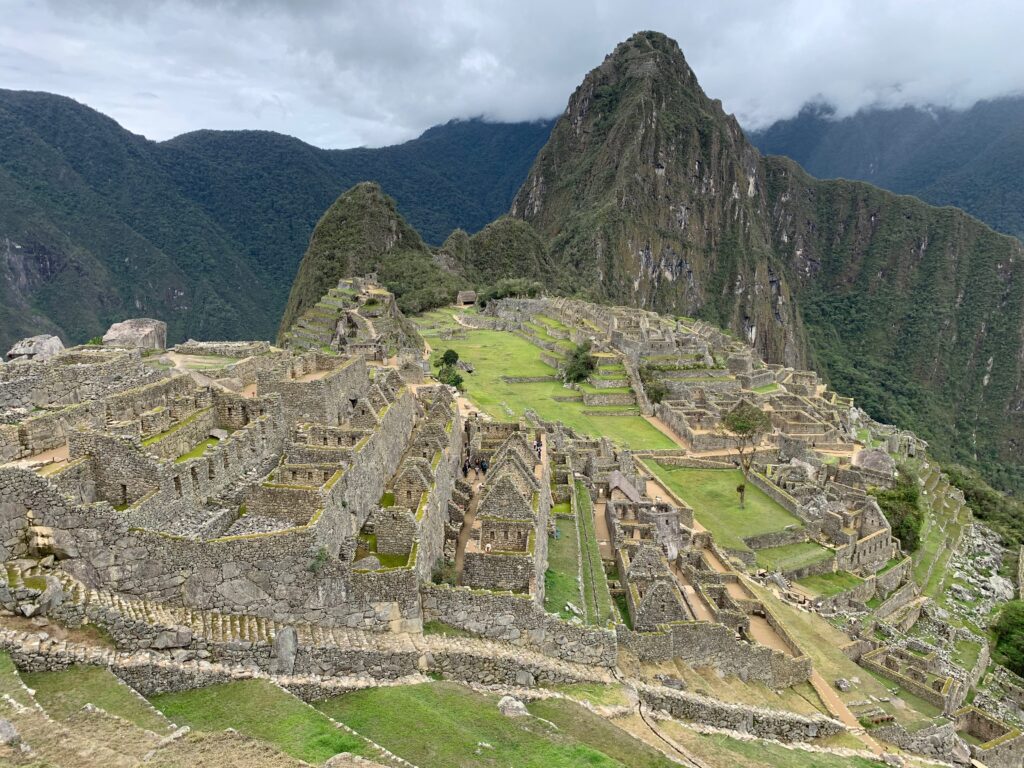
Huchuy Picchu towers over the ancient city.
To be honest, I was slightly underwhelmed after a while. I thought the scale of the place would be greater, more epic, as it were, and would set me back on my heels. I had expected something much larger, much more visually impressive. But despite that, this is one of the great wonders of the world, one of the great achievements of what we like to think of, but should not, as a primitive society. There was little primitive about a people who could muster the engineering skills, not to say the vision, to achieve this. Machu Picchu is a stone city, a small city but a city nonetheless, built on top of a mountain. The stone is granite, mostly boulders but some stones cut to shape and fitted in place without mortar, like the huge rectangular lentils above doorways, or the squared-off corner pieces of buildings. The name Machu Picchu (2,360m) means old mountain and right opposite it, so close it seems you could almost touch it, is Huchuy Picchu (2,479), which means young mountain. The young mountain looks down on the old one, almost with a protective posture. The top of Machu Picchu slopes to one side and thus the city faces predominately in one direction, looking out on the ring of other mountains in the area. All the mountains are granite and, unusually for someone from Ireland where glaciation has fashioned our granite into gentle slopes like the backs of whales, the mountains here are like pointed towers, whose sides are almost 90 degrees and only the tops rounded.
From the vantage point of where one enters the city, you can see how it was laid out. It was built between 1400 and 1450, by approximately 20,000 people and no slaves. Inca society functioned according to a number of principles — there were rules to be obeyed, people had to work, there was a quest and respect for knowledge, and there was love. Boys learnt maths, astronomy, science and physics until 10 years’ old, or so. After that, they left Machu Picchu for Cusco to teach others until they were 16 and then led whatever life they wanted. “For the Incas it was very important to spread the knowledge and to love it,” said Ruth. “In the inca’s time, the rich people have not a lot of money but a lot of knowledge.” Sounds good to me.
According to Ruth, six to eight hundred people lived in Machu Picchu at any one time and the great focus — apart from the daily routine of growing maize, potatoes and tomatoes on numerous terraced fields for survival, and maintaining an irrigation system — was astronomy. The city was also something of a summer residence for Inca royalty. There was no army to defend the city: the only protection from attack was a perimeter wall. The place was abandoned around 1530 — amazing to think that it was lived in for only just over 100 years — because of the Spanish invasion and was lost for 350 years until German cartographers rediscovered it in 1864.
It was the Germans surveyors who named it Machu Picchu. But the substantial rediscovery, and the basis of our understanding of the place now, came in the early 20th century. An American explorer, academic and later politician, Hiram Bingham, excavated the site, sponsored by Yale University and National Geographic magazine in 1911. Bingham took thousands of objects, ceramics, human remains, jewellery, back to the university where most remained until a few years ago when finally they were returned to Peru. The ancient city has essentially two distinct clusters of buildings, separated by a central green area. The left side, Ruth explained, was dominated by religious buildings, whereas the right hand side was for living, for the most part, even though on that side is the wonderful Temple of the Condor. Two huge boulders, with dark streaks in them, are splayed in a V shape . . . and look something like a giant bird. There is a Temple of the Sun with a window placed strategically to catch the dawn sunlight of the December solstice — shades of Newgrange. Inside the Temple of the Sun, pools of water were decanted into shallows in rocks so that the reflection of the stars could be studied at night. Far below Machu Picchu, at the bottom of the valley, Ruth explained that the river was named Willkamayu (the sacred river) “because the shape of the river looked like the Milky Way”.
“The Incas didn’t take water from the river but used spring water from the mountain. The Incas said the river gave them fish. Today, there’s no fish because the river is always polluted,” she said. Foul water from Machu Picchu itself was mixed with ash and used as fertiliser on the vegetable terraces.
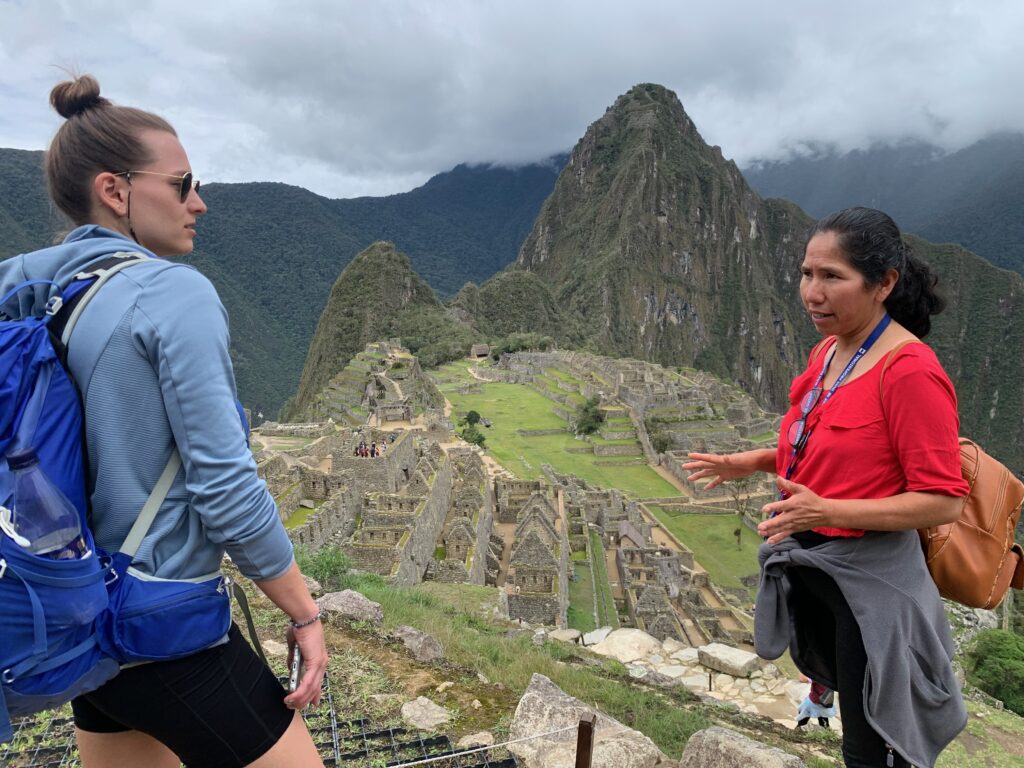
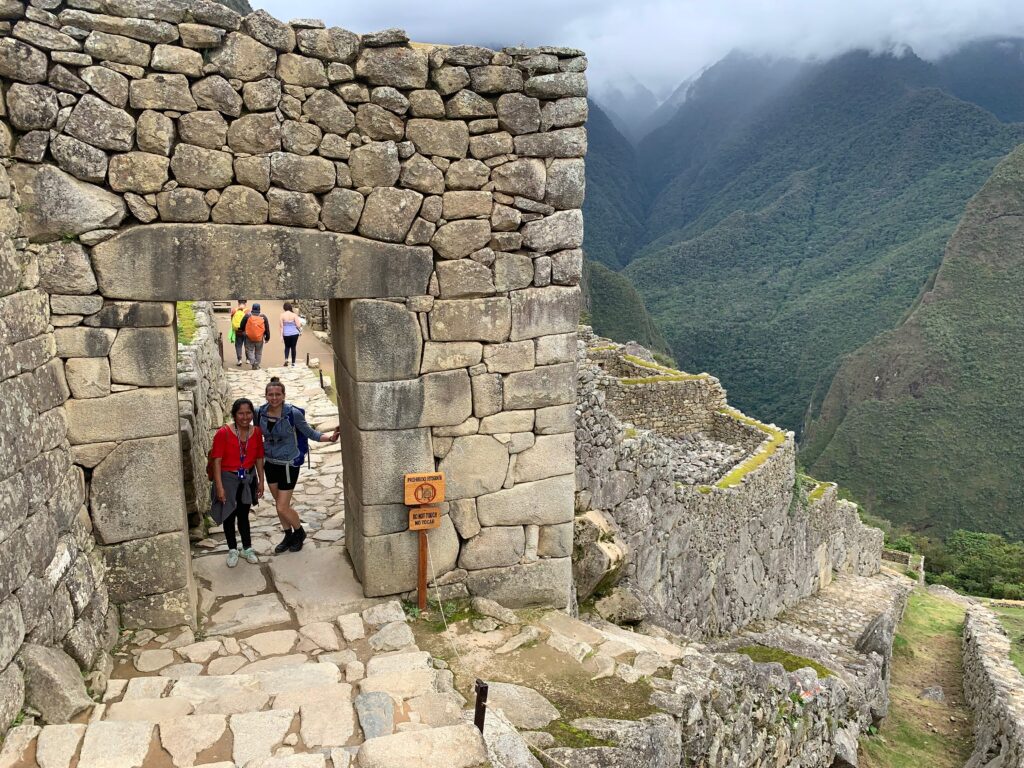
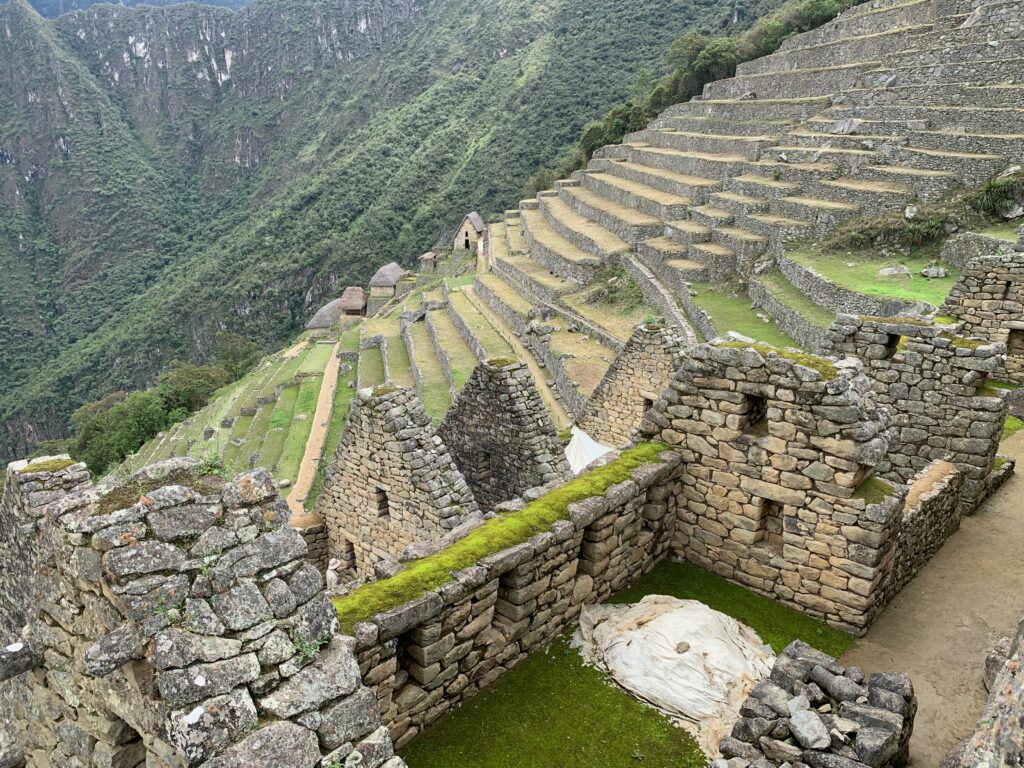
Ruth explains the city layout to Nicole; the dry cut stonework and the terraces.
You can pause and look down on the city and you can walk through it, seeing close up the small houses, narrow streets, temple building and the open green space between the two clusters. It is kept very well and there’s a sense of respect for the place and the people for whom this was somewhere important, sacred even. But I didn’t get a sense of those people, the Incas, who they were and what they were about. Maybe that’s my lacking . . . There is, for sure, something magical about the setting — perched atop a pinnacle of granite, surrounded by mountains of like shape and all covered in jungle-like vegetation.
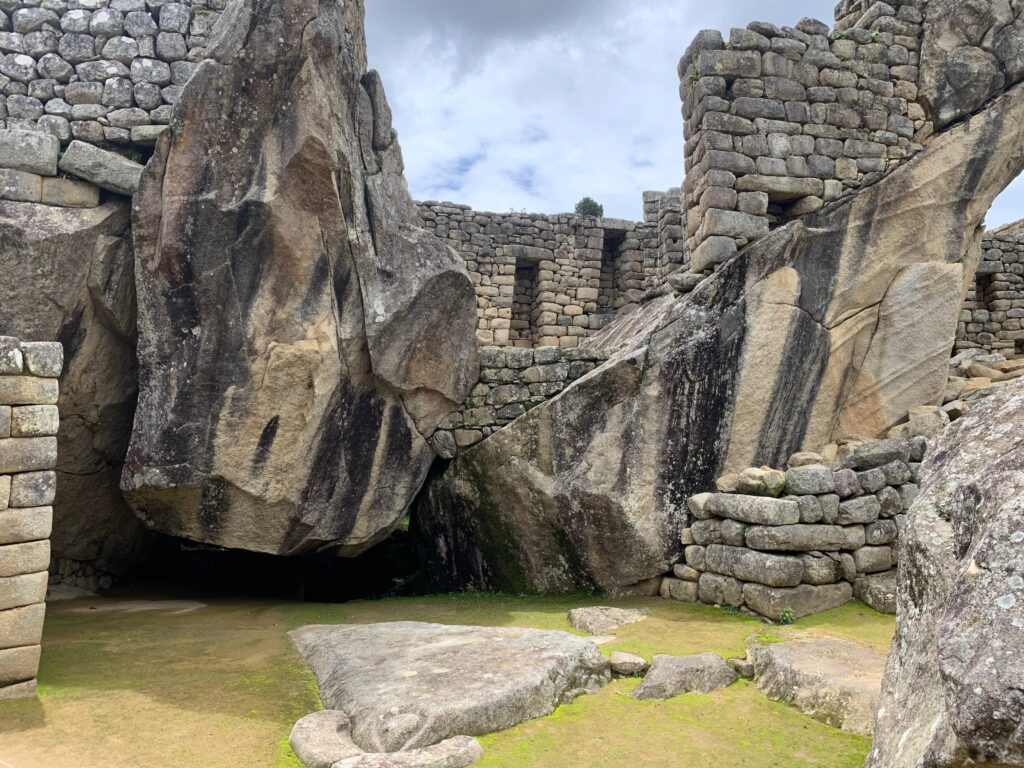
The Temple of the Condor.
The Temple of the Condor had a very specific purpose: it was used for the ceremony to mummify the dead. They were then placed in urns which were taken higher up, above Machu Picchu itself, closer to the god. “They were embalmed in the foetal position in death,” said Ruth, “because that is the way we came out and that was the way to go back to Mother Nature.”
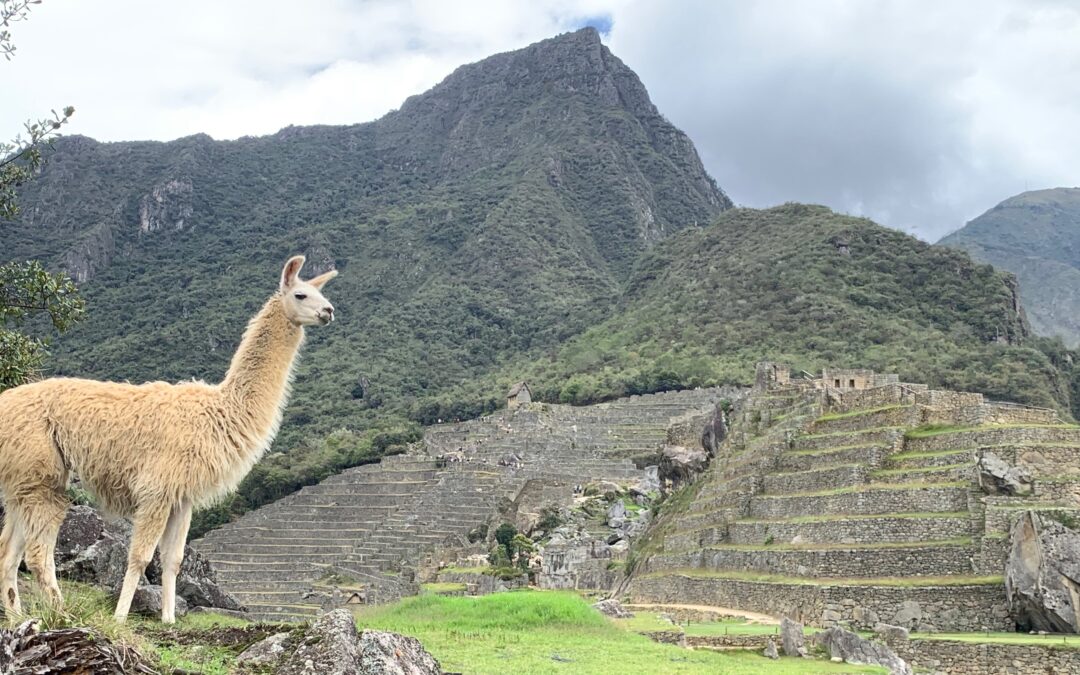
Hi, stumbled across your blog having searched for info on the disturbances in Peru on the Irish Times website. I was aware of your trip but have really enjoyed your blog – i have only read the posts from Peru and Bolivia so far reliving my own 7 months of wanderings in South America back in 1989. Machu Pichu, the Salar de Uyuni , hiking around Huascaran. It has also prompted me to follow your route on Google maps. I am amazed by the distances – which I must have covered by a whole succession of night buses
All the best with your trip
Thanks Willie. It’s certainly an interesting part of the world. Some days I ride longer than others — for no particular reason, it just happens! But I’m very comfortable doing 200+kms and then pulling in for a shower and beer and a bit of writing… Am now in Ecuador, btw. Thanks for reading — Peter
Hello, my family and some close friends were fortunate to have stayed in Peru for two weeks over the Christmas period. My husband is from Peru and I am from Ireland, but we live in the US. This was our first trip back post covid. We stayed up in the Sacred Valley and took in Machu Picchu December 28th (our 3rd visit and my birthday). We love our visits to Peru, but I have always loved my visits to Cusco and the Sacred Valley the most. I just love the surrounds and food and the people are just so lovely. This visit though has to have been by far our best visit to Peru. Because of the political unrest earlier in December (cancelled until Jan 4th though) we virtually had the place to ourselves. Our first visit to Machu Picchu was back in 2001 after doing the Inca Trail and our last visit to Machu Picchu was not unlike an overcrowded visit to Disneyland. We were so dismayed by the size of the crowd. But this time, due to so many cancelling their visit, we virtually had the place to ourselves. The weather was breathtakingly beautiful. There was not a cloud in the warm blue skies. We were up there by 6 am and were literally the first through the turnstiles. We finally, on our third attempt, saw the sun rise over Machu Picchu and it did not disappoint. During our visit, we climbed Huayna Picchu having the summit virtually to ourselves. I told my husband afterwards, that I have no need to go back to Machu Picchu because I really don’t think that the day we spent there could be bettered in any way from the perfect weather, to sunrise over the Citadel, to the lack of crowds, to the amazing birthday lunch to the fun filled train ride home. Safe travels on your way north. Ruth
What lovely memories you have and great to have climbed Huayna Picchu — well done! I agree about the crowds. I feel I was very lucky to have been there with only a couple of hundred others. The idea of thousands trekking around those narrow paths on a hot day fills me with dread! I am now in Colombia, having gone through Ecuador and the Galapago and will be heading shortly for Panama. I hope you can come along with me, in a manner of speaking, by dipping into the blogs. Best wishes and thanks for your memories. Peter